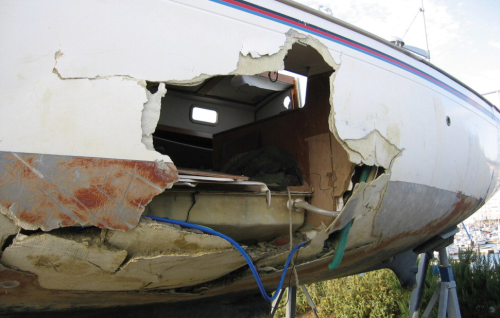
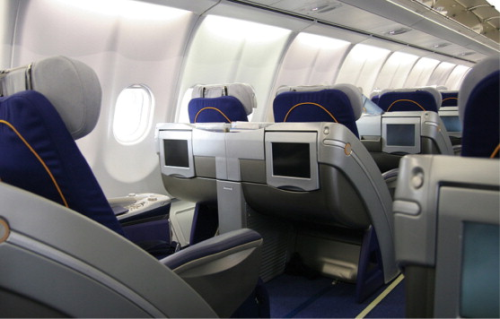
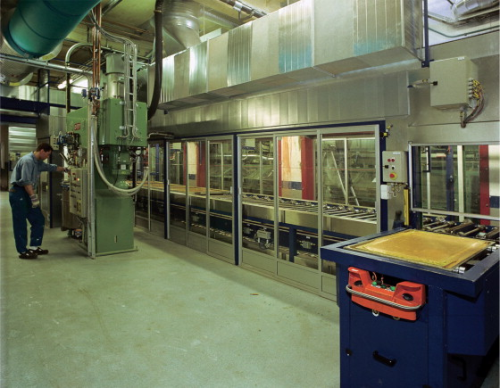
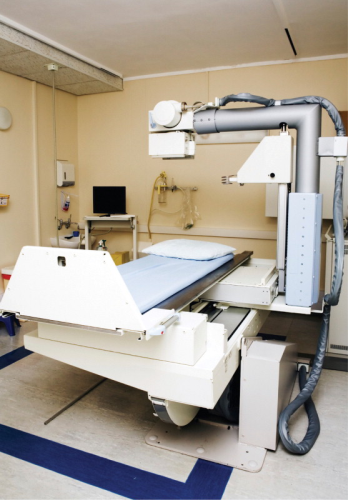
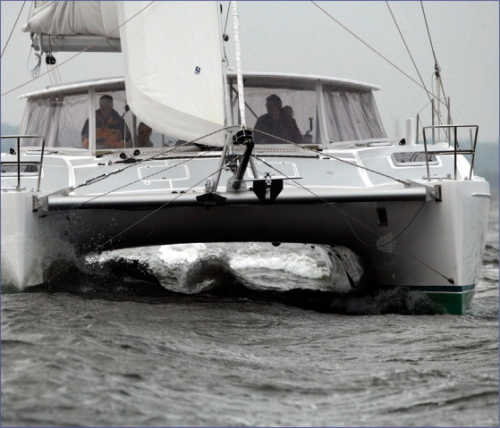
Core materials are central, literally and figuratively to composite sandwich structures. Their properties have a profound influence on those of the sandwich panel as a whole. For instance, increasing the thickness of the core, and hence the separation between the compression and tension load-bearing face sheets, greatly increases panel stiffness, the latter being proportional to thickness cubed.
Cores are far more than just spacers and must resist shear and crushing loads, as well as contribute impact strength and adhere well to the face skins to prevent core and skins from peeling apart. They must also provide a host of application-dependent properties from thermal tolerance to compression creep resistance, from particular dielectric characteristics to screw pull-out strength. Processing requirements typically include compatibility with a range of resin systems, infusability, high and low curing temperatures, stability during cure and in some cases thermoformability.
One type of core making inroads across a range of application sectors is structural foam. Plastics technologists are able to foam a variety of polymers – polyurethane (PU), polyvinyl chloride (PVC), polyethylene tetraphthalate (PET), styrene acrylonitrile (SAN) and polymethacrylimide (PMI) are examples – to form rigid or semi-rigid closed-cell structures having structurally advantageous properties. Cores may generally have seen less innovation than reinforced plastic laminates but, with recent developments, have been catching up.
One leading driver behind recent core progress has been DIAB, which is headquartered in Sweden but has major branches in the USA, Italy and the Far East. DIAB scientists and technologists constantly strive to improve the breed, producing new formulations and refining existing ones. First step in securing a desired mix of properties, says the company, is to select an appropriate polymer, or polymer combination – one which can be foamed consistently to yield a closed-cell structure that will set rigid at the end of the process. After that it is a matter of manipulating cell morphology (size, shape, wall thickness etc) to obtain the desired properties. The polymer surface characteristics must be made suitable for bonding, and various formulation refinements are used to promote such qualities as thermal tolerance, elasticity, resistance to chemicals and so on.
According to Chris Kilbourn, US-based vice president, special projects, who has an R&D background, a big issue in structural foams is securing the necessary uniformity in cell size, density, reaction characteristics during production and other aspects.
“Uniformity is a constant challenge,” he asserts. “This is especially so with thermosets where you’re making the foam and plastic at the same time. With thermoplastics the polymer is already made and that frees you to concentrate on the foaming aspect.”
Consequently, successful foam production requires a special emphasis on manufacturing process repeatability and close quality control. Inability to achieve consistent, controllable production has been the downfall of many foam core material projects.
FST challenge
Another challenge has been to improve the behaviour of polymer-based foams in fires. In particular, specifiers of interiors for aircraft and public surface transportation acknowledge the advantages and high mechanical properties of certain foam core products but have long called for variants that produce fumes with minimal flame, smoke and toxicity (FST) in fires. Only sandwich structures having low FST can satisfy the regulators in these safety-of-life critical application sectors. DIAB president and CEO Andres Paulsson argues that a dearth of commercially available low-FST structural foams up to now has held back affordable foam-based composite sandwich solutions. ‘Up to now’ because DIAB's new Divinycell F, given its first public airing at last month's JEC show in Paris, is expected to fill that gap.
“We have succeeded in developing a product that exhibits the high mechanical properties inherent in our established H range but combines these with low FST characteristics,” Paulsson told Reinforced Plastics. “We have been discussing this new product with key customers in aviation and surface transport over the last couple of years, and several evaluation and qualification processes are on-going. Working with academic and industry partners, we have been able to move the new core forward into production and are now very happy to start satisfying the demand that's out there.”
Whereas H Grades are based on a mix of PVC with certain thermoset components, DIAB moved to a new base polymer for its F grade. Though the company would not confirm it, sources suggest that polyether sulphone (PES) thermoplastic is the lead constituent.
“We go back to basics from time to time,” says Paulsson, in justifying the shift. “Sandwich foam has many advantages. It is rigid, light and strong and can have high impact resistance. Foam avoids the internal condensation that can degrade components based on other core structures and the material is homogenic, having the same properties in all directions. Foams offer designers great freedom in shaping and styling. Laminators appreciate their low resin consumption and consequent weight saving. All that was lacking, until recently, was a viable low-FST structural product. We took a completely fresh look and came up with an answer.”
Use of the new backbone was first mooted in the late 1980s.
“At that time, we investigated several different polymers and short-listed six or seven before finally settling on one that we considered would best support low FST as well as other required properties,” explains Chris Kelbourn from DIAB's Texas facility. “After a series of R&D trials, however, the project was abandoned due to prohibitive material and manufacturing costs. Since then, the cost of the base material has reduced and it has become possible to produce the foam in a continuous economic process rather than in batches.”
Accordingly, recent years have seen the project reinstated and now Grade F is a market reality. The fire-safe product has been assessed as meeting the latest stringent European Union transportation fire standards as well as those for trains in Germany. It also meets the Federal Aviation Agency (FAA)'s requirements for aircraft interiors, having met its OSU, vertical burn and toxicity criteria. Original equipment manufacturer (OEM) approvals (believed to be with leading airframers) are pending and should be in place later this year.
Initially the product is being marketed in three densities: 50, 90 and 130 kg/m3. These will not be the end of the line as more densities will be added, probably extending the range to some 400 kg/m3 at the upper end and down to below 40 kg/m3 at the lower. (Core mechanical properties are strongly correlated with density, while weight is inversely correlated).
“We have to date produced a density of 38 kg/m3 in a core-quality product,” says Chris Kilbourn, who will head up DIAB's FST product line, “but we have customers who would like a density as low as 30.”
Cure temperatures in the range 180-200°C compared with 140-150°C typical for established Divinycell products constitutes an extra ‘F’ benefit, enabling higher service temperatures to be endured in finished products. Higher temperatures can also facilitate faster processing, for instance by prepreggers.
Andres Paulsson sees Divinycell F as complementing other cores on the market.
“There's a home for every type of product,” he declares. “No single core is good for everything and, over the years, we see a growing diversity of materials targeting a range of applications. Just as important as the core material itself is the need to work closely with customers and fabricators to achieve good, competitive sandwich products. You have to know and understand sandwich structure. We have technical service teams working with customers in all our key market areas.”
Nevertheless, ‘F’ will no doubt compete with other products, DIAB's own H Series included. It might, for example, challenge honeycomb for use in heads and galleys, where its closed cellular structure and consequent lack of liquid uptake are advantageous. It could displace existing cores via hybrid structures in which both foam and honeycomb, say, will be used. For instance, a sandwich panel might have a low-density central honeycomb region surrounded towards the part's edges by a low FST foam core, so avoiding the use of conventional heavier alternatives and epoxy putty at hard mounting points.
To cope with expected demand, DIAB is currently constructing a new production facility in a leased building in Dallas, Texas. This will produce as much Divinycell F as a nearby facility in DeSoto produces H Grade, effectively doubling US foam production capacity overall. ‘F’ will also be produced in Sweden.
As well as developing this major low-FST product, DIAB has significantly enhanced its H Grade range. Over recent years it claims to have achieved a 10% hike in strength properties and a 60% increase in elongation to break, along with improved ductility, thermal and dimensional stability. A substantially reduced cell size underpins mechanical improvements and reduces resin uptake, and hence weight, during sandwich manufacture. Divinycell H can be processed at up to 90°C with minimal dimensional change. Divinycell HP is an elevated temperature variant offering a 130°C processing temperature, compatible with low and medium temperature prepreg systems. The higher temperature capability has been secured without, says the company, sacrificing mechanical properties. A new low-density addition to this range, HP60, offers the established HP benefits with a nominal density of just 65 kg/m3, permitting further weight reduction in lightly loaded sandwich structures. Meanwhile, an upgraded Divinycell HT utilising an enhanced foam polymer should appeal to aircraft interior specialists. It is non-hygroscopic, has superior impact/damage performance and offers improved dielectric properties. Available densities span the range 65-130 kg/m3.
DIAB is not the only company to target the low FST sector. Alcan Composites Core Materials claims that its recently announced Airex T90, based on a PET polymer backbone, will be useful for floor and sidewall panels in rail and road applications where FST requirements are stringent. The product is said also to offer easy processing, being usable with all types of resin and a variety of laminating processes. According to the company, PET's high chemical resistance means it is unaffected by the styrene content of certain resins, while out-gassing and post-expansion are described as non-issues. High thermal stability enables PET foam to be processed with prepregs at up to 150°C. Moreover, the material's visco-elastic behaviour means it is readily thermoformed. The closed-cell structure and physical properties of PET serve to prevent moisture ingress and foam degradation, while good mechanicals confer high static load resistance. As company spokesman Markus Wanner points out, an advantage of PET is its ready availability, the polymer being widely used in clothing and a range of industrial applications. Airex T90 is available in various thicknesses at densities ranging from 100 kg/m3 to 400 kg/m3.
High Impact Technology LLC of Oregon has hopes for a product that combines thermoplastic skins with its HIT polyolefin foam core-based foam. The result, it claims, is a thermoformable fire-safe sandwich panel that can meet low FST requirements. The HIT foam has reportedly earned an FAA fire rating already and there are plans to assess the material's fire and smoke emissions when it is subjected to Amtrak's light rail test. A complete Poly-Kore panel is made by combining HIT foam with face skins of Thermo-Pro reinforced thermoplastic tapes made by Polystrand Inc of Colorado.
Degussa Röhm GmbH says a fire-resistant methacrylic resin is used in the ROHACELL® polymethacrylimide (PMI) foam product it supplies for the front end of the Avanto tram-train (from Siemens Mass Transportation, Germany, and Jupiter Plast, Denmark). This vacuum infused sandwich structure is claimed to be the first composite structure to comply with the requirements of the DIN 5560 crash standard.
Multiple products
Marketing multiple core products to cover as many application areas as possible is a leading industry strategy. DIAB's product portfolio is notably broad, while Alcan Composites Core Materials likewise addresses diverse applications with its AIREX, BALTEK and KAPEX structural core lines. Degussa has at least nine grades of its highly rigid PMI core with which it targets sectors ranging from sports to aerospace. Rohacell RIST and RIMA grades designed for resin infusion processes have cell sizes tailored for lowest possible resin absorption. Degussa says its Röhm Rohacell products offer unsurpassed strength-to-weight ratios, high thermal stability and high resistance to compression creep, while their superior fatigue tolerance make them suitable for applications exposed to high dynamic loads, like helicopter rotor blades. A high performance grade with augmented dimensional stability and compressive creep resistance can be used as a lay-up mandrel on which outer skins can be formed. Because this foam can also withstand a 180°C autoclave cure cycle, it proved possible to vacuum bag and cure an entire part developed for a Japanese rocket launcher in one shot.
Gurit (SP Systems) secures different grades of its SAN-based Corecell foam by mediating at molecular level the reaction between the styrene and acrylonitrile monomers that results in the foam. Its process is said to deliver highly consistent and controllable results such that, for example, density variations within a given material grade are minimal. Corecell, originally developed as a tougher alternative to cross-linked PVC foams, is noted for its high toughness, impact resistance and fatigue tolerance. Marine grades for instance, have become the material of choice for the forward hull sections of performance yachts that are subjected to high slamming loads. The latest variant is intended for wind turbine blades. As well as being compatible with polyester, vinyl ester and epoxy resins, Corecell is said to be compatible with all commonly used epoxy prepregs unlike, says the company, some cross-linked PVC foam systems. Other claims are that Corecell has shorter manufacturing cycle times than its competitors, cures without outgassing, is highly thermoformable and is easy to cut, sand and shape.
Reinforced core
Cellular manipulation is one way to achieve high core values for composite sandwich structures. Another approach is to follow the general laminator's lead and reinforce the core plastic with fibre. In particular, use of short or long fibres to reinforce thermoplastics, an established trend in structural laminates, is extending to core materials.
Tennessee-based Penske Composites LLC manufactures reinforced structural urethane core material products for marine and industrial markets. Recently acquired by Alcan Composites, Penske is well known for its ‘Xtreme’ high-density fibre reinforced cores, used in highly stressed items such as outboard engine-bearing boat transoms.
Another US company, Albany Engineered Composites, uses a network of pultruded carbon fibre/epoxy needles to reinforce PMI foam. Multiple quarter to half millimetre diameter needles, disposed throughout the core as a truss structure, not only reinforce the core but, because they project into the sandwich face skins and are co-cured with them, also help to unify the sandwich structure and augment peel resistance. Since the carbon/epoxy needles have a coefficient of thermal expansion which matches that of carbon/epoxy face skins, panels utilising Albany's K-COR material can be used in situations characterised by high temperature differentials, such as near liquid hydrogen fuel tanks in rockets.
Ohio-based Webcore Technologies Inc stitches fibre reinforcement through closed-cell PVC foam sheets to form a core structure that is fortified in the z direction as well as the x/y directions. The resulting TYCOR is resin infused along with the face skin fabrics, to form a strong sandwich panel.
European truck trailer producer Composittrailer has developed a process in which reinforcement fibre is ‘stitched’ through the entire sandwich panel, providing significant z-direction reinforcement through the full thickness. Its Acrosoma panels are therefore tri-dimensional reinforced sandwich structures which, as well as having fibre reinforced core, have the top and bottom face skins tied together, improving peel resistance. Panels up to 80 mm thick can be produced in various sizes using a range of skins, foams and stitching fibres for different applications.
The remarkable stiffness and high strength-to-weight of contemporary com-posite sandwich is contributing to the effectiveness of structures as diverse as aircraft, space rockets, road and rail vehicles, marine craft, sports and leisure equipment and buildings. Until recently laminates forming the outer skins have made most of the running in terms of innovation and developmental progress. However, cores have been catching up, to the benefit of composites technology as a whole.






